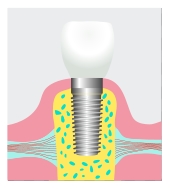Dental Implants
 Dental implants are the modern alternative to dentures, and one of the most desirable methods for replacing missing teeth. Over the past four decades, they have proven to be highly successful, giving you a more natural looking smile and functioning alternative to bridges or dentures. Dental implants can be used both to perform full-mouth restorations and to improve cosmetic appearances, and a variety of methods for using them have been developed.
Dental implants are the modern alternative to dentures, and one of the most desirable methods for replacing missing teeth. Over the past four decades, they have proven to be highly successful, giving you a more natural looking smile and functioning alternative to bridges or dentures. Dental implants can be used both to perform full-mouth restorations and to improve cosmetic appearances, and a variety of methods for using them have been developed.
Using Dental Implants in Restorative Dentistry
Losing a tooth, either to trauma or extraction, can cause issues for the surrounding area of your mouth. The surrounding teeth may shift into the open area, and the bone may be reabsorbed into the body. By placing an implant in the place of a missing tooth, all parts of the tooth, from cusp to root, are replaced, without the need to damage healthy teeth as is needed with a bridge. With the look, feel, and function of a natural tooth, an implant not only offers visual improvement, but practical purpose as well.
In some cases, all of a patient’s teeth will need to be replaced. In the past this could only be accomplished with dentures. Patient who suffers from loose dentures can have dental implants attach to their dentures to secure and keep their dentures in place, called implant overdenture.
Benefits of Dental Implants
While bridges and dentures can be useful, dental implants have several advantages over these older methods, including:
1. Improved Esthetics:
Implants resemble a natural tooth, with a titanium post supporting a custom built crown. They offer a realistic, natural look to patients.
2. Reduction of bone resorption:
The bone structure that used to support a missing tooth will be reabsorbed by the body over time. This can cause instability for surrounding teeth and cause further problems down the road. An implant provides stability by reducing the rate of bone loss.
3. Retention:
Implants can hold dentures in place securely, eliminating the challenges of adhesives or suction required to keep dentures in place without them.

4. Preserving natural tooth structure:
Before implants, the preferred method of replacing a single missing tooth was dental bridges. The replacement tooth would be held in place by cementing them to the surrounding teeth. This process requires your dentist to prepare the bridge by cutting into the adjacent teeth. An implant is an independent unit that does not require alteration to adjacent teeth.
5. Improved Dental Hygiene:
Implants only require the same regular brushing, flossing, and regular dental examinations that a natural tooth does, avoiding the need for special cleaning or extra attention.
6. Improved Function:
Implants are fused permanently into your jaw to become a part of your body, and will function exactly as natural teeth will. Your speaking and chewing abilities are preserved without causing pain in the gums when biting into hard surfaces. They do not run a risk of warping, shrinking, or otherwise not fitting properly, and do not cause irritation or inflammation of the soft tissues of the mouth through regular use.
If you’re looking for a great implant dentist in Flower Mound, or have questions about this procedure, please call Dazzle Dental Care today to make an appointment.
